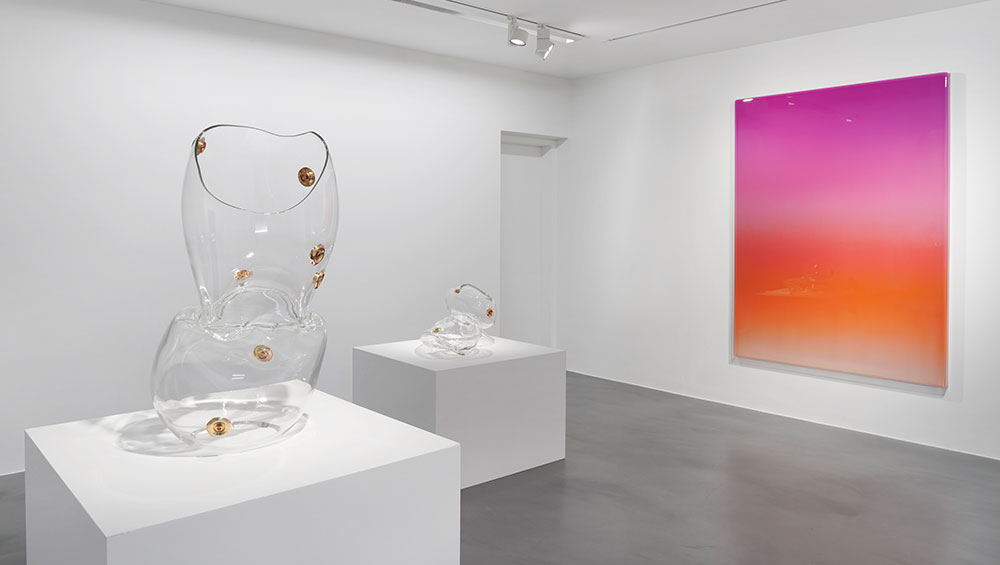
Mika Tajima: Regulation, installation view, Simon Lee Gallery, London 2021. Photo: Ben Westoby.
Simon Lee Gallery, London
12 April – 8 May 2021
by CHRISTIANA SPENS
How are we regulated? And how do we regulate ourselves and the world around us? In Mika Tajima’s new work – including sculptures made from rose quartz and large-scale paintings using textiles, the artist explores concepts of energy dynamics and flows between humans and the world around us, from the natural to industrial worlds, exploring the implicit tensions between these different forces. Articulating what it is to be a “life force” oneself, Tajima delves into what it means to be human in a world of ever-expanding and increasingly powerful technologies, especially when they are controlled by the ideology and structures of capitalism and all that it entails.
Tajima’s projects, while abstract and cerebral, signify a quiet existential crisis and resistance at the heart of modern life, which we can all relate to on some level. Including new works from her Art d’Ameublement, Negative Entropy, and Pranayama series, as well as a new group of glass sculptures titled Anima, Regulation presents a materialisation of these concerns, implicitly teasing out the cerebral, intellectual and intangible conflicts that so often resist categorisation or true reflection.
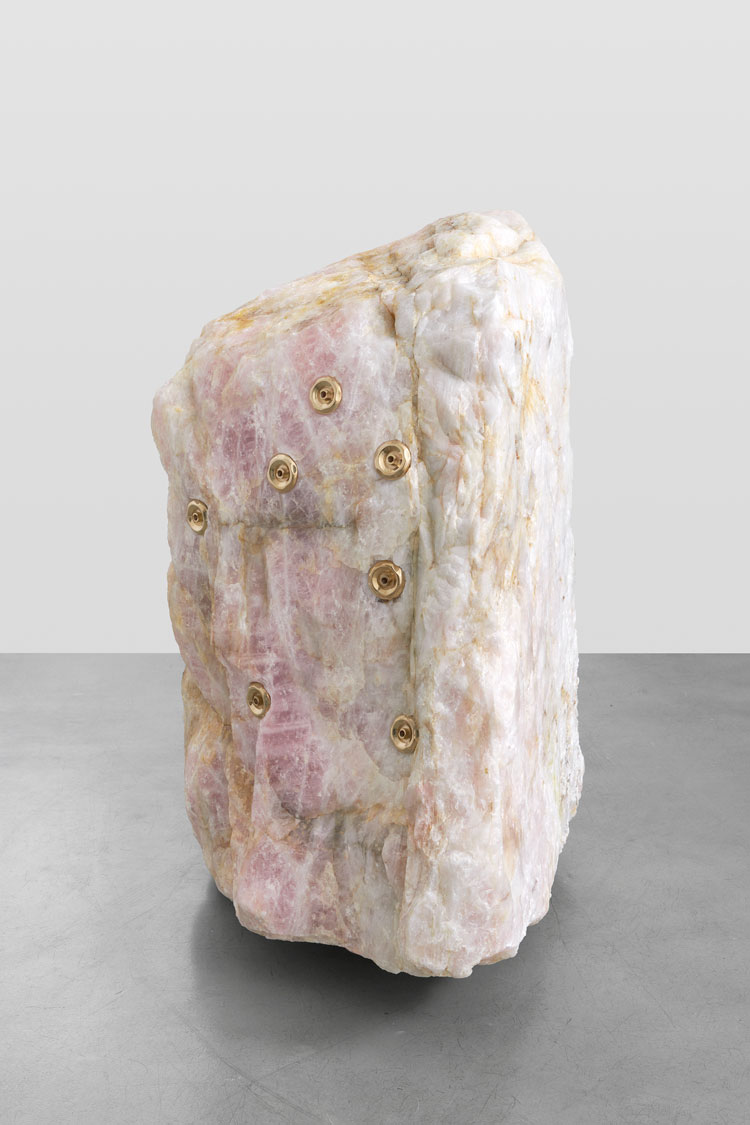
Mika Tajima. Pranayama (Monolith, E, Rose Quartz), 2020. Rose quartz, cast bronze jet nozzles, 91.4 x 55.9 x 63.5 cm (36 x 22 x 25 in). Image courtesy of the artist and Kayne Griffin Corcoran. Copyright of the artist.
In the latest works in her Pranayama series, for instance, Tajima presents a group of sculptures carved from rose quartz and embedded with bronze nozzles cast from Jacuzzi jets. The use of rose quartz is new for Tajima, whose previous sculptures have been of wood or marble, and adds a spiritual, mesmerising component to the work – effectively a monolithic crystal standing in the centre of the gallery. Rose quartz is believed by some to affect the physical energies flowing within the body, as well as the flow of electricity.
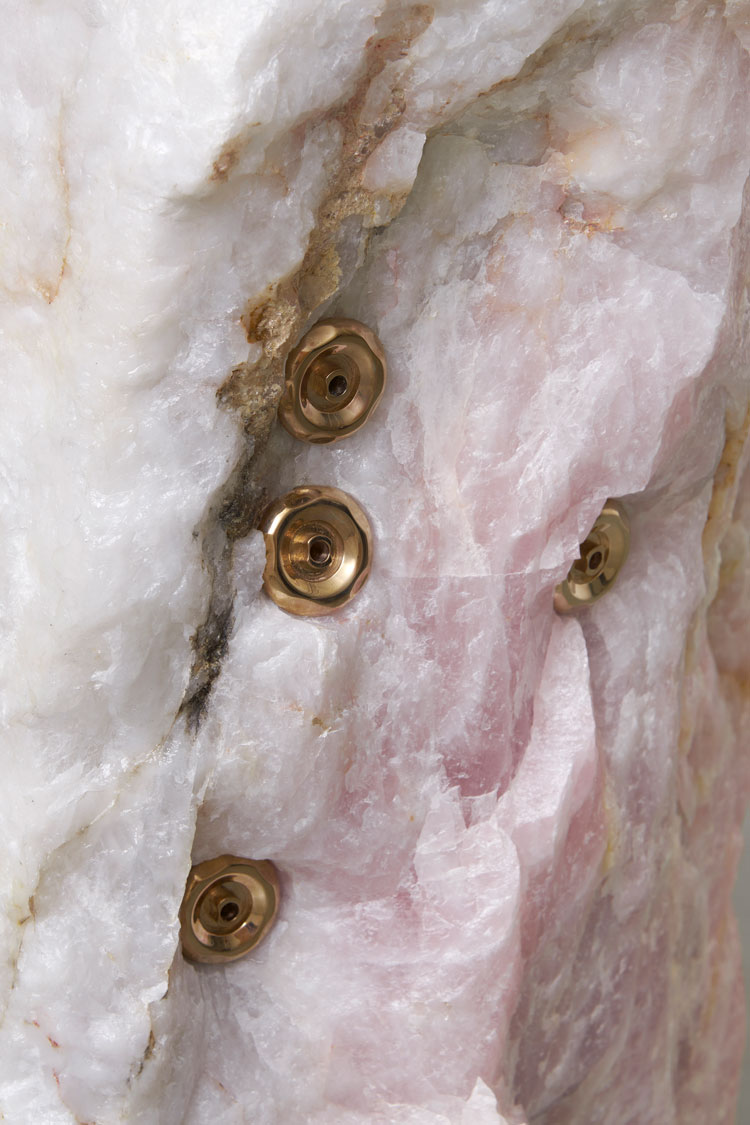
Mika Tajima. Pranayama (Monolith, E, Rose Quartz), 2020 (detail). Rose quartz, cast bronze jet nozzles, 91.4 x 55.9 x 63.5 cm (36 x 22 x 25 in). Image courtesy of the artist and Kayne Griffin Corcoran. Copyright of the artist.
The bronze Jacuzzi nozzles mimic pressure points on the human body, intimating the potential for input and output, or a harmonious flow of energy. With its title, Pranayama, a reference to exercises to control breathing (which comes from the Sanskrit word prana, meaning life force), this latest work asserts the power we have to regulate and reform our bodies, and their relation to the outer world, and external, perhaps conflicting, life forces. A subtle act of resistance to exterior forms of “regulation”, this piece asserts that we retain our individual freedoms to regulate ourselves and our relation to the exterior world and other forces.

Mika Tajima. Anima 6, 2020. Glass, cast bronze jet nozzle, 48.3 x 50.8 x 35.6 cm (19 x 20 x 14 in). Image courtesy of the artist and Kayne Griffin Corcoran. Copyright of the artist.
Also visually striking are Tajima’s new series of blown-glass sculptures. Titled Anima, these cast glass vessels – the surfaces of which are also studded with bronze jet nozzles – are curvaceous and contained, seeming fragile yet intimidating at first glance. Taking its name from the Latin word “anima”, which mean breath or life force, this work encases breath within a solid object. The Jacuzzi nozzles mimic the release and escape of the breath; here, however, the glass and air of these works are in stark contrast to the heavy, grounded quality of the rose quartz. There is a feeling of interplay between these sculptures, a flowing of energies, which in itself is fascinating.
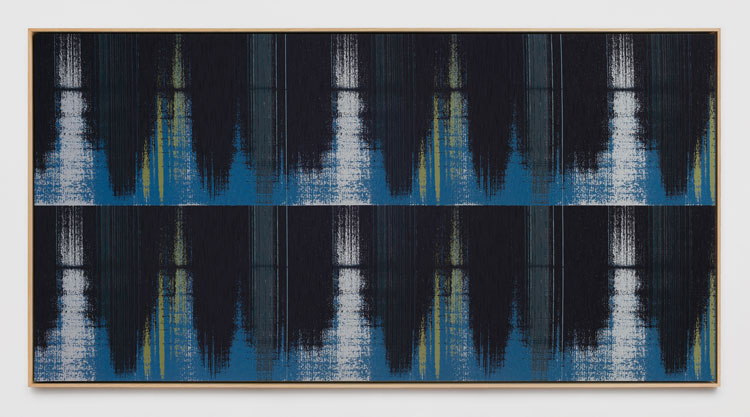
Mika Tajima. Negative Entropy (RSK Sanyo Broadcasting, Master Control Switchboard, Blue, Hex), 2020. Cotton, polyester, nylon, rayon, wool acoustic baffling felt, and white oak, 144.5 x 279.1 x 7.5 cm (56 7/8 x 109 7/8 x 3 in). Image courtesy of the artist and Kayne Griffin Corcoran. Copyright of the artist.
Surrounding these sculptures are new works from Tajima’s Negative Entropy series. A set of large-scale, abstract images, made from jacquard textile, they provide a visual representation of audio recordings from industrial sites, including a data centre, a broadcasting company, a laboratory producing biomedical textiles, and a construction site. Reminiscent of electrocardiograms showing the electrical activity of the heart, these fascinating works seem to capture and disembody the force of sound, showing how sound itself is a regulation of, or resistance to, what we conceptualise as time.
_11914_1_P.jpg)
Mika Tajima. Negative Entropy (Inscape, Beginning Meditation, Pale Orange, Double), 2020. Cotton, polyester, nylon, wool acoustic baffling felt, and white oak, 142.6 x 110.2 x 5.7 cm (56 1/8 x 43 3/8 x 2 1/4 in). Image courtesy of the artist and Kayne Griffin Corcoran. Copyright of the artist.
Philosophically curious and aesthetically pleasing, this project is inspired by the concept of negative entropy, a term in quantum physics that means the opposite of entropy. Negative entropy is, in other words, a way of creating order in a wider system. By translating sound into visual work, Tajima explores what it means to capture and represent life forces, revealing how difficult it is to measure and fully understand aspects of life and communication such as linguistics and the human thoughts and emotions behind them. While revealing these intangible, unknowable aspects of life, she also shows that we can create new beauty, force and information in our “meddling” with these systems and how we process and reimagine them.
_11905_1_P.jpg)
Mika Tajima. Art d'Ameublement (Karake), 2020. Spray enamel, thermoformed PETG, 182.9 x 137.2 cm (72 x 54 in). Image courtesy of the artist and Kayne Griffin Corcoran. Copyright of the artist.
The Art d’Ameublement works are large paintings, what the artist calls “aerated paint particles” captured in acrylic frames. Here, paint is a “mist” that has been caught in a frame. Using industrial machines to produce these works, the artist describes them as “ambient” pieces, inspired by Erik Satie’s Furniture Music (Musique d’ameublement). These works play with the industrial production of paint and colour, and seek to contain and reform these processes in new ways. Again, Tajima offers a playful and cerebral resistance to the external forces we almost take for granted, creating a sort of magic by reforming and resisting these structures, and revealing the beauty of the properties themselves.
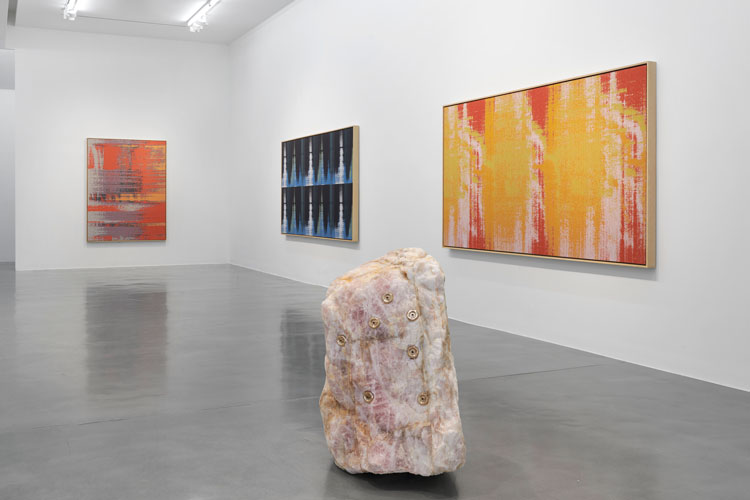
Mika Tajima: Regulation, installation view, Simon Lee Gallery, London 2021. Photo: Ben Westoby.
Regulation, as it combines these different instances of capture, articulation and representation of various life forces, affects a compelling stillness and beauty, even as it is drawn from ideas of subjective dissonance with wider structures, and their seeming intangibility. The gallery becomes a space of meditation and revelation, in which we can see the deeper resonance of the structures and forces we often take for granted, and our own potential for resistance, imagination and repositioning ourselves in relation to the rest of the world.